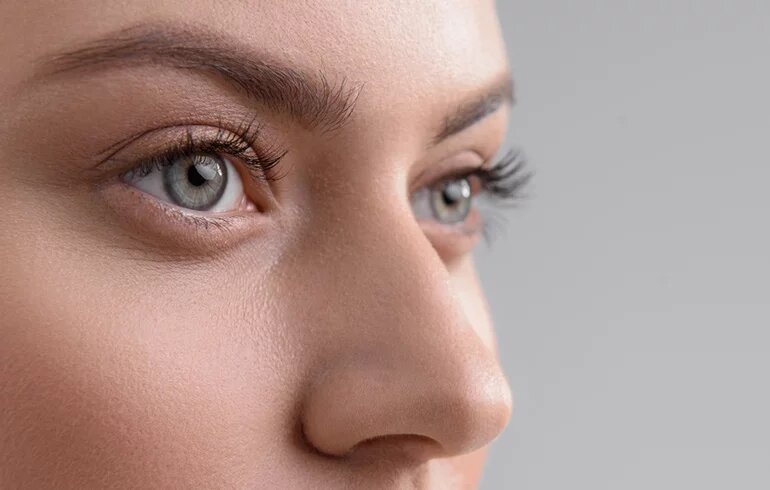The shape and size of the nose markedly determines the overall look of the face. As with the ears, this part of our body can grow throughout our lives, so if you have an already large nose, you may become even more dissatisfied with the overall effect as you age. This is because, as the fullness of the facial skin and connective tissue decreases with age, the nose becomes even more prominent. The nose’s deformities and irregularities can be corrected surgically.
Rhinoplasty
When is rhinoplasty warranted?
There can be several reasons for rhinoplasty. Most rhinoplasty procedures are performed for aesthetic reasons, as the shape and size of the nose significantly affect the character of the face, and therefore the first impression to others, which in the worst case can lead to loss of self-confidence and self-esteem. Congenital deformities or those due to injury are not only an aesthetic problem, they also have a negative impact on quality of life. Rhinoplasty can solve these problems at once, harmonizing the overall look of the face and having a positive impact on life. Healthy breathing through the nose can be restored with an ear-nose-throat operation, correcting a deviated septum, which can be combined with rhinoplasty. However, it is important to know that the final results of rhinoplasty can only really be seen one year after surgery. Since the skin must also adapt to the change in the bony-cartilage area, in this case the key word is patience!
What happens at the first consultation?
Our plastic surgeon will examine you during a personal consultation and show you, based on their references, what your expected best outcome will be if you decide to have surgery. They will also inform you about the necessary correction and surgical procedures. Rhinoplasty - even though many such operations are completed every year - is not a simple routine intervention, as no two noses have the same structure, hence no two rhinoplasty surgeries are the same.
Preparing for surgery
As with all surgeries, you will need to have a full examination before rhinoplasty, which includes laboratory tests and, if necessary, an ECG and x-rays. In our private hospital, we perform all the necessary tests at the same time to save you time and make your preparations for rhinoplasty more convenient. You will then receive some lifestyle tips to help you prepare for surgery and to speed up your recovery. These include quitting smoking - at least temporarily - as nicotine slows the healing processes, consuming adequate amounts of fluids, vitamins and trace elements (vitamin C, selenium, zinc) and avoiding the use of aspirin, ginkgo biloba and other natural remedies, because these affect blood clotting.
What happens during surgery?
Our plastic surgeons currently use two types of surgical techniques, open and closed rhinoplasty. The latter is much more common, with the plastic surgeon only making incisions inside the nostrils, leaving no visible external scars. Open rhinoplasty is warranted when a bigger intervention is necessary - such as after multiple nasal surgeries - so that an incision is made in the surface of the skin separating the nostrils. In both cases, the deforming cartilaginous and connective tissue structure-forming parts are removed and the nasal tip is reshaped. If the length of the nose is also shortened, a part of the nasal septum is removed. Bone spurs in the nasal bridge and the curvature of the nose can be reshaped by filing down. In addition, correction of a deviated septum by an ear-nose-throat specialist can also be performed within one surgery. Our plastic surgeon uses only absorbable sutures throughout, sparing you the inconvenience of a later suture removal. At the end of the operation, a swab is placed in the nostrils to prevent bleeding ¬- for one day in the case of nasal surgery, or for two days after nasal septum plastic surgery - and a waterproof adhesive strip is applied, or the bones and cartilaginous part are fixed with plaster. Rhinoplasty under anesthesia takes 1-1.5 hours.
Recovery, regeneration
After rhinoplasty you will need to spend one night in our private hospital, where you can relax in pleasant and comfortable surroundings (a minor intervention under local anesthesia warrants six hours of observation). Bruising may occur around the eyes and dark circles may appear in this area for some weeks. The swelling of the nose will gradually fade, but when the plaster bandage is removed the tissues do not yet show their final shape. During the first two weeks you should avoid any strenuous physical activity. You can then gradually resume your previous rhythm of life. After six weeks light exercise is allowed, but in the case of ball games the grace period is eight weeks. Neither the solarium, sunbathing nor the sauna are advised for two months. Our plastic surgeon will call you back for a postoperative examination at specified intervals. Wound healing takes 18 months, with the nose’s definitive form final after 12-18 months.
Although we try to eliminate all risk factors during preoperative rhinoplasty examinations, unforeseen complications can occur. At the first consultation your plastic surgeon will inform you about these and how to avoid them.
